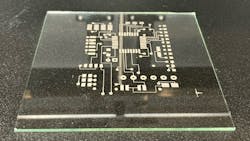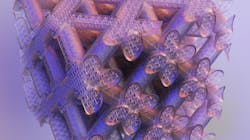Additive Manufacturing Innovations Drive Industry Forward
In the evolving field of additive manufacturing, several innovations have emerged that have helped to drive the industry forward. From the development of advanced and multi-materials for 3D printing to the advent of sophisticated software and engineering platforms for enhancing the 3D printing process to the increasing investment in and use of 3D printing by universities, Machine Design keeps its finger on the pulse of the additive manufacturing industry.
Let’s explore a few of these innovations and their capacity to transform the next phase of manufacturing.
Advanced Multi-materials for 3D Printing
A significant innovation in additive manufacturing lies in the expansion and diversification of the materials used in the 3D printing process. Beyond traditional plastics and metals, recent advancements have allowed manufacturers to create products with improved properties and functionalities.
Take multi-material 3D printing, for example. As nano3Dprint CEO Ramsey Stephens noted in a Q&A, “No longer is multi-material 3D printing just about using different colored filaments; instead, it introduces material diversity by embedding into the design functional inks and pastes, which possess dynamic qualities, including conductivity, magnetism, sensing capabilities and responsiveness to external stimuli.”
Manufacturers can incorporate functional materials into everyday devices, leading to the creation of custom devices like wearables, sensors, batteries and solar cells. “This customization can conform to space limitations and design constraints, accelerating innovation and research and development while reducing costs,” Stephens said.
Another advancement in 3D printing materials can be found in dental prosthetics and other medical solutions where high-accuracy printer platforms and biocompatible materials are used. Desktop Health (a brand of Desktop Metal) and Carbon—both leaders in the oral health additive manufacturing space—joined forces this past summer to bring the Flexcera family of resins to the Carbon Digital Manufacturing Platform.
The collaboration opened access to the nanoceramic resin for use in 3D printing permanent dental restorations, as well as advancements in digital dentistry, providing exceptional strength, life-like aesthetics and long-term performance.
Software, Engineering Platforms for 3D Printing
To complement the advancements in materials, software and engineering platforms streamline the 3D printing workflow and allow for design flexibility.
The integration of platforms dedicated to 3D printing has changed the way products are designed, tested and manufactured. Cutting-edge software solutions allow users to create complex designs, optimize support structure generation and simulate the printing process to identify potential issues before they arise.
These platforms facilitate communication between designers and machines and have resulted in customization, quicker prototyping and cost-effective manufacturing.
Dr. Elissa Ross, co-founder and CEO of Metafold—the developer of a Design for Additive Manufacturing (DfAM) cloud-based software—told Machine Design about the technology behind its computation engine. She said the company recognized the need for new digital tools to support 3D printing manufacturing technology and address the limitations of traditional CAD systems.
“[CAD systems] were developed for conventional manufacturing, and they are excellent in those capacities,” she said. “But when it comes to supporting high complexity, geometry—that is…what 3D printing is really great at—those same digital tools are traditional CAD tools. They don’t offer what we need.” Metafold’s technology addresses that, she said.
At the center of the platform is its geometry computation engine, which Ross said enables the design and optimization of complex geometries for 3D printing. The web application offers capabilities for creating lattice geometries, lightweight parts and high-surface area structures, which opens possibilities for a range of industries where optimized structures are highly valuable.
One of the key strengths, she noted, is the material and process agnosticism. Users can access the software via the cloud and API, regardless of the hardware used for 3D printing. This flexibility allows manufacturers to optimize their additive manufacturing processes, whether designing lightweight aerospace parts or creating efficient heat exchangers.
There are platforms to access and print parts as they are needed, too. Markforged, for example, offers Digital Source, an on-demand parts platform that allows for licensing and 3D printing of manufacturer-certified parts at the point of need. The platform enables vendors to upload digital part designs, which can then be licensed to customers, distributors and contract manufacturers. Once uploaded, end-users of the platform gain the flexibility to license the right to print parts either onsite or through a network of approved print service providers.
According to Jeremy Haight, principal engineer at Vestas Wind Systems A/S, Digital Source allows spare parts to be printed where needed, so the company got its machinery up and running faster. “Time equals a very high dollar value for us,” he said. “A line down in one of our factories is a big deal but a turbine that has gone down can cost even more.” He said if they can access and print the part needed, the turbine can be up and operational much quicker.
Learning Institutions Invest in 3D Printing
In addition to materials and software advancements, investment in 3D printing by universities is driving growth in the additive manufacturing sector.
Universities and other higher-learning institutions have begun to recognize the potential of additive manufacturing and are investing in the technology. By establishing dedicated research centers, labs and courses in additive manufacturing, these institutions are fueling innovation and preparing a new generation of experts in this emerging field.
The collaboration between academia and industry has resulted in cutting-edge research, advancements in materials and the development of novel manufacturing techniques. Those that invest in 3D printing contribute to a knowledge-sharing ecosystem, helping to accelerate the adoption and development of additive manufacturing technologies and concepts. This progressive approach can foster the growth of 3D printing across a range of industries, stimulating innovation and economic development.
To support Missouri manufacturers and enhance their competitive edge, for example, the Kummer Institute Center for Advanced Manufacturing at Missouri University of Science and Technology (S&T) made a significant investment in technology. The purchase of a large-format metal 3D printer from SPEE3D is a crucial step toward incorporating additive manufacturing into the state’s industrial sector.
Dr. Richard Billo, director of the Center for Advanced Manufacturing, emphasizes the importance of additive manufacturing becoming the new norm for Missouri manufacturers to thrive globally. “For Missouri manufacturers to succeed on the global stage, additive manufacturing must become the new normal,” he says, noting that the upcoming Missouri Protoplex, an advanced manufacturing research and development facility set to open in fall 2025, is where the new printer and other equipment will be housed.
Apart from supporting manufacturers’ projects, working with the WarpSPEE3D printer provides undergraduate and graduate students at S&T with valuable experience and understanding of challenges faced by manufacturers. Students can program the printer, document operating procedures, design CAD models, perform testing and develop maintenance plans. This holistic approach to workforce development aims to equip students with hands-on experience in product development and manufacturing methods.
As additive manufacturing continues to advance, the university’s investment in equipment and research will play a pivotal role in supporting Missouri manufacturers, enabling them to embrace innovative technologies and maintain a competitive edge in the global marketplace.
Across the country at the University of California, Berkeley, students who are part of Space Enterprise Berkeley worked with Protolabs to manufacture 3D-printed components for the Eureka-1’s (E-1) plenum and parachute system, achieving their goal of throttling and launching the first ever bi-propellant liquid-fueled rocket powered by a collegiate rocketry team.
The E-1 was three years in the making for the SEB team as part of their goal to become the first collegiate rocketry team to pass the Karman line, which divides Earth’s atmosphere and outer space. The December 2022 launch of the rocket put the team well on its way when it reached more than 11,000 feet in altitude.
The rocket’s plenum and parachute system were printed via selective laser sintering (SLS) with PA12 40% glass-filled nylon. According to Asa Garner, structures lead, the team researched the options and ultimately chose this material due to its strength, temperature resistance, long-term wear resistance and cost-effectiveness.
Garner explained that without 3D printing the team couldn’t iterate on the component designs as quickly as they did for this project. “Both of the critical main parachute bulk heads were entirely 3D-printed and we’re using thermoplastic heat set inserts to fasten them to our primarily fiberglass airframe,” he said.
Garner and his team plan to use 3D printing and machining for various components in their latest project, the Eureka-2 rocket, which they plan to reach an altitude of 20,000 feet. The key learnings from that launch will pave the way for what the team hopes is a Karman-line surpassing Eureka-3.
Driven by innovations such as advancements in materials and software, as well as universities investing in the technology, additive manufacturing continues to make progress as Machine Design continues to report on its potential.
About the Author
Sharon Spielman
Technical Editor, Machine Design
As Machine Design’s technical editor, Sharon Spielman produces content for the brand’s focus audience—design and multidisciplinary engineers. Her beat includes 3D printing/CAD; mechanical and motion systems, with an emphasis on pneumatics and linear motion; automation; robotics; and CNC machining.
Spielman has more than three decades of experience as a writer and editor for a range of B2B brands, including those that cover machine design; electrical design and manufacturing; interconnection technology; food and beverage manufacturing; process heating and cooling; finishing; and package converting.
Email: [email protected]
LinkedIn: @sharonspielman
Facebook: Machine Design
YouTube: @MachineDesign-EBM




